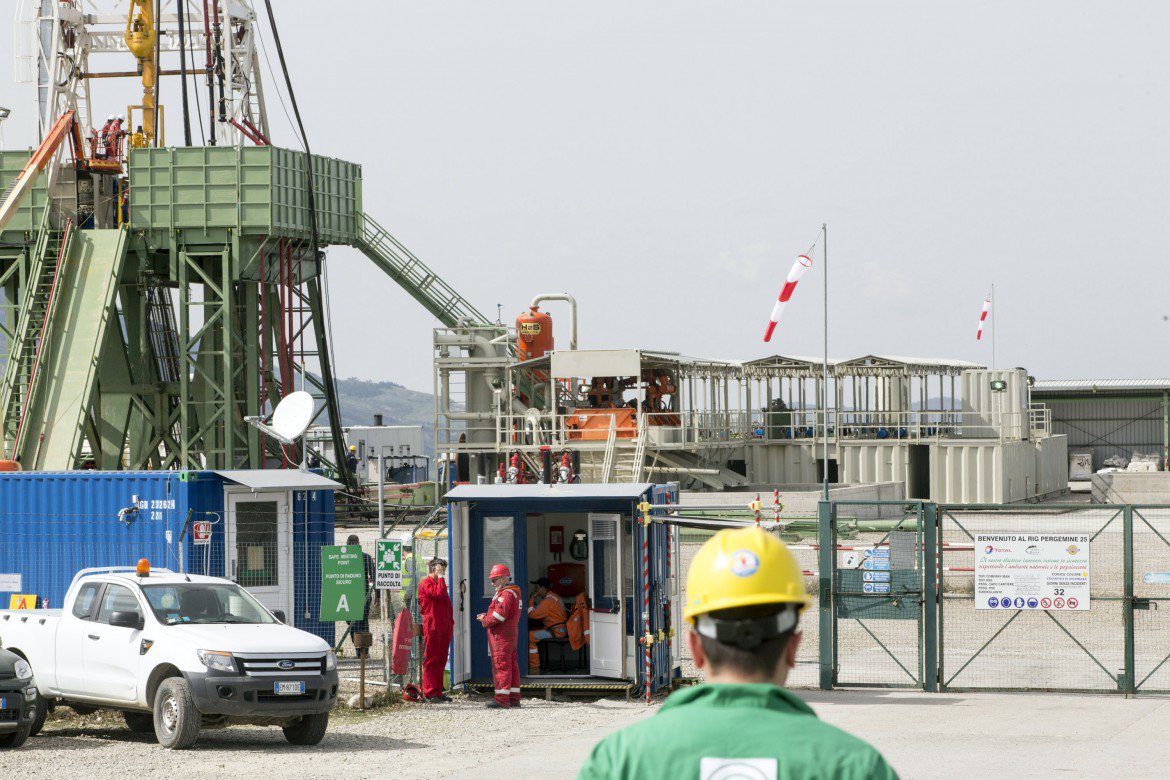Drills
Hands on Lucan oil
Total and Shell split up the concessions. At risk landmarks like Accettura, considered one of the "most beautiful villages in Italy". Five "permits" on a thousand square kilometers of territory. 47 municipalities concerned. Ionian Calabria and Campania are overrun. In the Cilento National Park

Five permits already approved, forty-seven municipalities involved, an affected area of nearly a thousand square kilometers, two multinationals, Shell and Total, taking the lion’s share.
It wasn’t enough with the twenty oil wells at Viggiano (the European municipality with the highest rate of drilling) plus the other seven at the Val d’Agri, the largest oil field in Italy and the new concessions of “Tempa Rossa” now under investigation; the Renzi government, with the decree Unlock Italy, has given the green light to turn the Basilicata region into a kind of region-gruyere.
The new frontier of this ‘ Black Eldorado”, as the oil lands of Lucania were defined in the thirties, is the area that is bordered at west by the south of Campania, and east by Ionian Calabria. The French company under the investigation targeted by the Potenza prosecutors was awarded the largest territory, that of Tempa La Pertosa, ranging from Senise, a municipality south of Potenza known for the production (protected by the Ministry of Agriculture) of pepper flakes (sun-dried), to the Ionian Sea, into five Calabrian municipalities: around 412 square kilometers.

But Total is entitled to seek the black gold as well in another internal area of Basilicata (around 188 sq km), which includes 12 municipalities of the Lucan Dolomites including Accettura (whose evocative woods and the ancient Feast of May impressed photographers like Henri Cartier Bresson and Mario Dondero, as well as painters like Carlo Levi and Ernesto Treccani) and Tricarico, home of the poet-writer Rocco Scotellaro.
The same exploration drill permit, ironically called “Oliveto Lucano” [Lucan Olive Woods] in homage to the plant-symbol of the area, includes also towns like Acerenza, Castelmezzano and Pietrapertosa, all three in the list of the 200 most beautiful villages in Italy.
From east towards west, the partition of the Lucania territory passes from French hands to the Americans.
Shell was awarded the “La Cerasa” permits (76 square kilometers and affecting five municipalities), “Pignola” (55 square kilometers and five municipalities, including the capital Potenza) and “Montecavallo”.
The latter is the most delicate one: out of 212 square kilometers, 161 are in Campania, and five municipalities (Polla, Padula, Sant’Arsenio, Sassano, Teggiano) are located within the National Park of Cilento and Vallo di Diano, well inside the protected area.
It is not the first time that a multinational tries to drill in these areas: at the end of the nineties, it was Texaco, which was forced to withdraw in response to the strong protest of the population, who would not suffer the same fate of the nearby Val d’Agri and did not believe in the American propaganda.
For now we are still in the skirmish phase: all municipalities involved have spoken out against drilling, while the Stars and Stripes company threw water on the fire to pacify the population: the permits are for the Environmental Impact Assessment only and nothing has been defined. But “in the notice published by the company Shell E & P SpA Italy” reports the website of the Lucan environmentalist organization (Ola),” an exploration drill is expressly provided for, wherever the structural and stratigraphic geological conditions of the substrate indicate a potential accumulation of hydrocarbons economically exploitable with authorization procedures under the Ministry of Economic Development, according to the procedures provided by law.”
Tramutola is also included in the Monte Cavallo permit, the symbolic center of the dream of Lucan oil. It was there that a blackish substance, bitumen, began to gush spontaneously from the bowels of the earth in the mid-nineteenth century, to the point that in 1878, a vial of the precious liquid was shown as a relic at the Universal Expo in Paris.
Since the thirties, the mountains of Tramutola became a fuel reservoir: between 1936 and 1947, Agip built 47 wells. At that time the entire basin ensured a production of about 100,000 barrels of oil and 7,000,000 cubic meters of gas. The Italian company (now Eni) is still the holder of the concession, but the wells were abandoned.
Oil still gushes in the woods, slimy and oily, not far from a water park, forming a kind of blackish stream that flows into the Cavolo river. Then, it flows into the Pertusillo artificial lake, which has been the subject of environmental complaints on water pollution on several occasions. Well, now in Tramutola, where for the first time the Lucan black gold was discovered and someone even attributed miraculous virtues to it, it the arrival of the Americans is expected.
Originally published at http://ilmanifesto.info/le-mani-sul-petrolio-lucano/ on 2016-04-08
